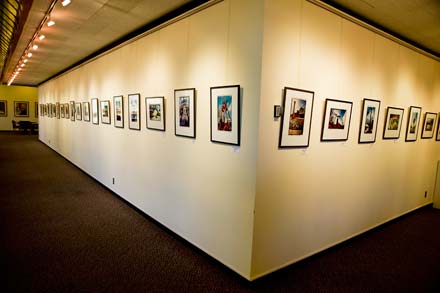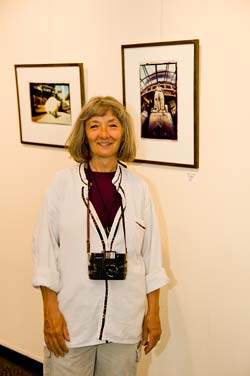|
A&E |
|
![]()

![]()
Artist finds inspiration
with old technology, urban landscape
The Advocate
Mt. Hood Community College is exhibiting “From One Pinhole to Another; The Art of Pat Bognar,” in the College Center’s Fireplace Gallery.
Bognar’s local photos were taken with a hand-made pinhole camera. “The pinhole camera is a nineteenth century concept; it is a box with a tiny opening made by the point of a sewing needle,” she said. “It has a long exposure of about 30 seconds to a couple of minutes.”
|
||||
The long exposure creates a soft effect, and along with color negative film, creates strikingly rich and intense color. Because the camera has no viewfinder, the photographer cannot see what they are taking a picture of.
Bognar’s style has consistently been labeled “urban landscape and street photography.” She says she likes the shadows of sunny days, packing a lot into the photo, and taking pictures from the ground looking up. She is continually inspired anew by the city. “I love Pioneer Courthouse Square. I love the umbrella man,” says Bognar as she was hanging her photos on the wall.
Since moving to Portland 15 years ago, she has yet to tire of street photography. If she does begin to get restless, she says, she’ll change her camera, her technique, or switch back to black and white — that gives her a fresh start.
“I shot exclusively in black and white for 25 years before I switched to color eight years ago, which I have used pretty much exclusively since.” Once in a while, Bognar will hop on a train and take a trip into the forest or the Columbia River Gorge, but the city remains her primary place of inspiration.
After studying art as an undergraduate at Columbia University in Chicago, Bognar received her degree in education.
While teaching elementary school in Chicago, putting bulletin boards together was her single creative outlet. “I made great bulletin boards,” Bognar said. But when a reporter from a local newspaper asked her to take some photos for him and placed a camera into her hands, Bognar knew she had been “brought back to art,” and “that was what I wanted to do.”
Bognar went on a three-week trip to Paris, France, and “into the second week, I decided to stay,” she remembered. She lived in Paris for 10 years, making a living teaching photography. She began teaching out of her home, then while walking down the street she found herself outside the door of Skidmore College.
Bognar knocked, was greeted, and introduced herself as a photography instructor. The secretary was thrilled to hear this, as the college needed a photography instructor.
There she taught photography through the late 1980s and into the early 1990s.
While in France, Bognar became “impassioned,” by the work of Vincent Van Gogh. “I read all of the letters of Van Gogh,” she said. “I put photos together of places he visited, painted and lived.” Bognar’s collection of photos was exhibited in the Van Gogh Museum in Amsterdam.
But after living in Paris, Bognar did not want to return to Chicago. She wanted a city with public transportation, as she was committed to living without a car.
“Some people in Paris spoke highly of Portland,” said Bognar, who soon made it her home. Shortly after arriving in Portland, she got a job teaching at the University of Portland where she has taught for 14 years. She is teaching an alternative processes class in photography and is the curator of the Buckley Center Gallery at University of Portland.
Bognar has not owned or driven a car for 26 years. Using public transportation and her bicycle, she is out taking photos seven days a week. “I do not leave home without my camera,” Bognar said. “I develop three to four rolls of film every Monday at U-develop.”
In response to how she thinks the recession will change art in Portland, Bognar says, “The recession has no importance.” She believes that the recession will not change art because “it has always been challenging. Photography has always had to struggle to be considered art.
“Art is not about money; it is a tool for knowledge and learning about oneself, self expression, and passion,” she said. “Photographers do not plan on becoming rich. A sale is a gift, but it isn’t why you do it.” Bognar said she is more driven by moments when “the luck of the camera gives me just what I wanted.”
![]()
The Advocate reserves the right to not publish comments based on their appropriateness.
![]()
Notice: Undefined variable: c5t_output in /hermes/walnacweb06/walnacweb06ac/b2874/moo.advocateonlinenet1/mhccadvocate/92109/fireplacegallery.php on line 219
![]()

